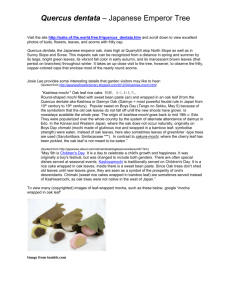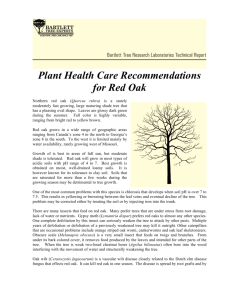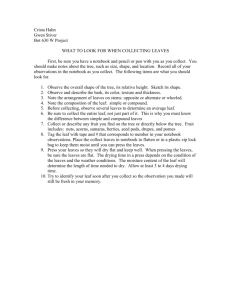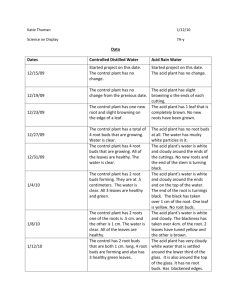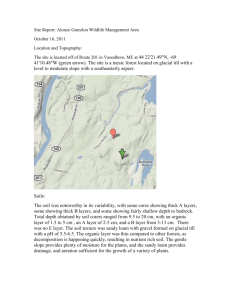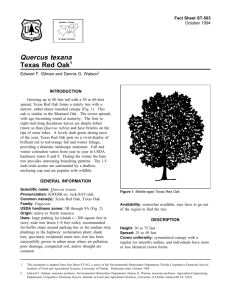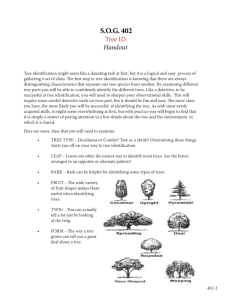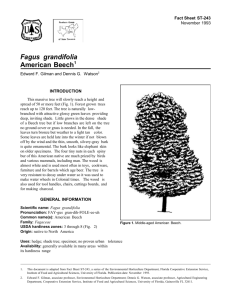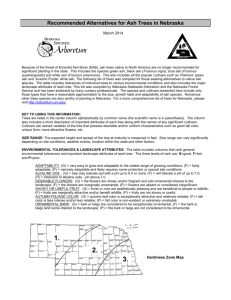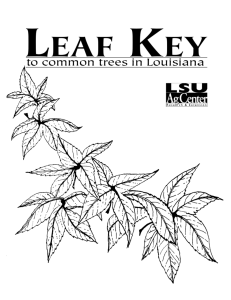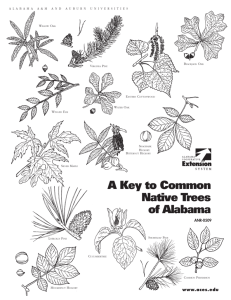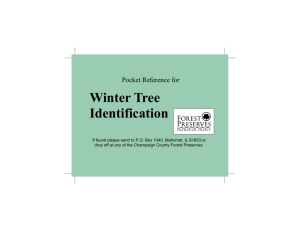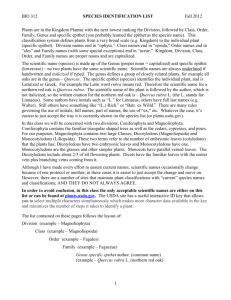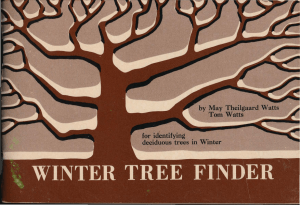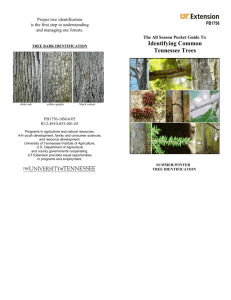File
advertisement
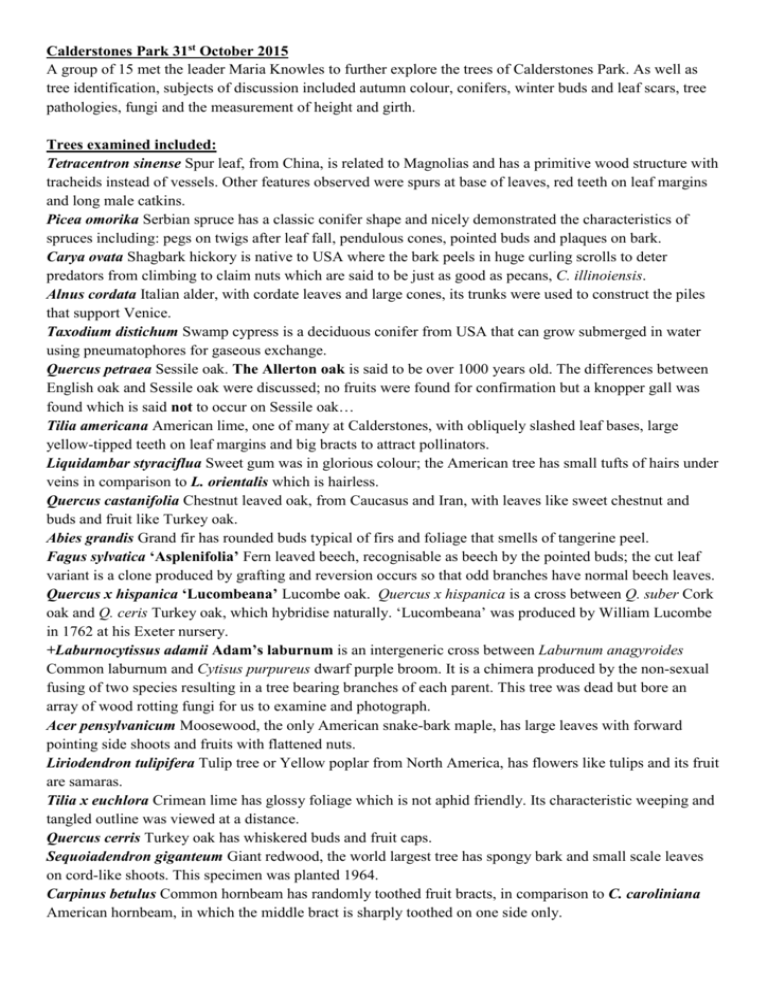
Calderstones Park 31st October 2015 A group of 15 met the leader Maria Knowles to further explore the trees of Calderstones Park. As well as tree identification, subjects of discussion included autumn colour, conifers, winter buds and leaf scars, tree pathologies, fungi and the measurement of height and girth. Trees examined included: Tetracentron sinense Spur leaf, from China, is related to Magnolias and has a primitive wood structure with tracheids instead of vessels. Other features observed were spurs at base of leaves, red teeth on leaf margins and long male catkins. Picea omorika Serbian spruce has a classic conifer shape and nicely demonstrated the characteristics of spruces including: pegs on twigs after leaf fall, pendulous cones, pointed buds and plaques on bark. Carya ovata Shagbark hickory is native to USA where the bark peels in huge curling scrolls to deter predators from climbing to claim nuts which are said to be just as good as pecans, C. illinoiensis. Alnus cordata Italian alder, with cordate leaves and large cones, its trunks were used to construct the piles that support Venice. Taxodium distichum Swamp cypress is a deciduous conifer from USA that can grow submerged in water using pneumatophores for gaseous exchange. Quercus petraea Sessile oak. The Allerton oak is said to be over 1000 years old. The differences between English oak and Sessile oak were discussed; no fruits were found for confirmation but a knopper gall was found which is said not to occur on Sessile oak… Tilia americana American lime, one of many at Calderstones, with obliquely slashed leaf bases, large yellow-tipped teeth on leaf margins and big bracts to attract pollinators. Liquidambar styraciflua Sweet gum was in glorious colour; the American tree has small tufts of hairs under veins in comparison to L. orientalis which is hairless. Quercus castanifolia Chestnut leaved oak, from Caucasus and Iran, with leaves like sweet chestnut and buds and fruit like Turkey oak. Abies grandis Grand fir has rounded buds typical of firs and foliage that smells of tangerine peel. Fagus sylvatica ‘Asplenifolia’ Fern leaved beech, recognisable as beech by the pointed buds; the cut leaf variant is a clone produced by grafting and reversion occurs so that odd branches have normal beech leaves. Quercus x hispanica ‘Lucombeana’ Lucombe oak. Quercus x hispanica is a cross between Q. suber Cork oak and Q. ceris Turkey oak, which hybridise naturally. ‘Lucombeana’ was produced by William Lucombe in 1762 at his Exeter nursery. +Laburnocytissus adamii Adam’s laburnum is an intergeneric cross between Laburnum anagyroides Common laburnum and Cytisus purpureus dwarf purple broom. It is a chimera produced by the non-sexual fusing of two species resulting in a tree bearing branches of each parent. This tree was dead but bore an array of wood rotting fungi for us to examine and photograph. Acer pensylvanicum Moosewood, the only American snake-bark maple, has large leaves with forward pointing side shoots and fruits with flattened nuts. Liriodendron tulipifera Tulip tree or Yellow poplar from North America, has flowers like tulips and its fruit are samaras. Tilia x euchlora Crimean lime has glossy foliage which is not aphid friendly. Its characteristic weeping and tangled outline was viewed at a distance. Quercus cerris Turkey oak has whiskered buds and fruit caps. Sequoiadendron giganteum Giant redwood, the world largest tree has spongy bark and small scale leaves on cord-like shoots. This specimen was planted 1964. Carpinus betulus Common hornbeam has randomly toothed fruit bracts, in comparison to C. caroliniana American hornbeam, in which the middle bract is sharply toothed on one side only. Castanea sativa This specimen of Sweet chestnut is a huge tree with characteristic spiralled bark and lots of fruit. Davidia involucrata Handkerchief tree, from China, this specimen is var. villmoriniana which has hairless leaves in comparison to the rarer var. involucrata, which is softly downy. The hanging fruits are used to identify the tree in winter. Dipteronia sinensis Chinese money maple is an unusual tree with compound leaves and fruits like elm. It a member of the Soapberry family and is grown ornamentally in USA for its elegant leaves, interesting fruits, but insignificant flowers Prunus serrula Tibetan cherry has attractive dark shiny bark. Polylepis australis from high altitudes in the Andes has many-layered peeling bark. This specimen has now sadly declined over the last few years and it has been propped. Zanthoxylum simulans Chinese pepper. The husks of the dried fruits are used as a spice, Sichuan pepper. The bark is magnificently spiny. Paulownia tomentosa Foxglove tree has purple flowers which adorn the bare tree in spring and huge flimsy leaves woolly on both surfaces. It is pollution tolerant and regrows after fire. Celtis occidentalis Hackberry or Nettle tree, from USA has small hanging edible berries on stalks. Ailanthus altissima Tree of Heaven is native to China and is aggressively naturalised in some American cities. It is identified by small lobes at the base of each leaflet, red ash-like keys, heart shaped leaf scars and tiny buds. 6 strategically planted conifers were compared: Taxus baccata Common yew has red arils and green shoots. Tsuga heterophylla Western hemlock has leaves of different lengths with petioles. Pseudotsuga menziesii Douglas fir has pointed beech-like buds, cones with forked bracts, and bark like crusty bread. Sequoia sempervirens Coast redwood has spongy bark and a gradation of leaf length. It is the world’s tallest tree and thrives in the coastal fog of California. Cephalotaxus harringtonia Plum yew or Cow tail pine has fruit like green plums, leaves which are bigger and more arched than yew, with soft spined tips and pale bands underneath. Cephalotaxus fotunei Chinese plum yew has bigger longer shiny leaves, with pointed but unspined tips. We counted how many different leaves we could identify beneath our feet! Birch, beech, oak, ash, alder, cherry, lime, tulip tree… Measuring tree height The height of 2 trees Alnus cordata and Taxodium distichum was measured using Alan Mitchell’s method. A stick is broken so that it measures the exact distance from the eyeball to the furthest stretch of the grasping hand. The stick is then held vertically at arm’s length and the holder walks backwards or forwards until the stick covers the tree accurately from base to leader. The distance from the person to the tree is measured and equals the height of the tree. Measuring tree girth Girth is measured at 5ft avoiding burrs etc. Trees grow faster when young and slower when old. Trees put on more girth when free standing and less girth when in woodland as girth is sacrificed to height. The average growth per year for a mature tree in good condition with full crown is stated to be 2.5cm. Sequoiadendron giganteum = 487cm in 51 years (planted 1964) = 9.5cm per year. Castanea sativa = 683cm. Age = 683/2.5 = 273 years old (estimate). Tree pathology Leaf miner Cameraria ohridella was observed in Aesculus hippocastanum, horse chestnut. Caterpillars of leaf miner moth mine leaves causing characteristic banding, discolouration and defoliation before normal autumn leaf fall. It is not considered to have a significant impact on tree health and leaves flush normally in spring; affected leaves can be composted to destroy pupae. Many thanks to all who came along and joined in. Maria Knowles

